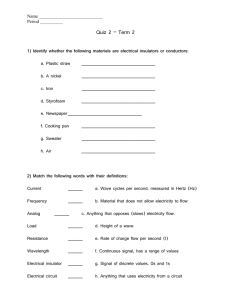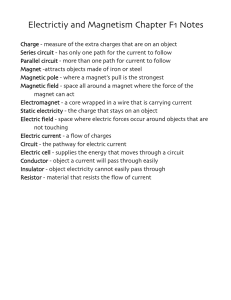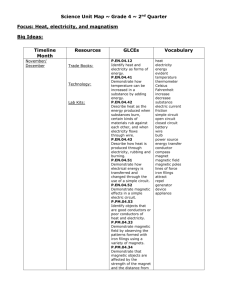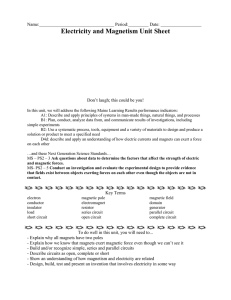IPC Physics Final Review Vocab Chapter 1 and 2—Speed and
advertisement
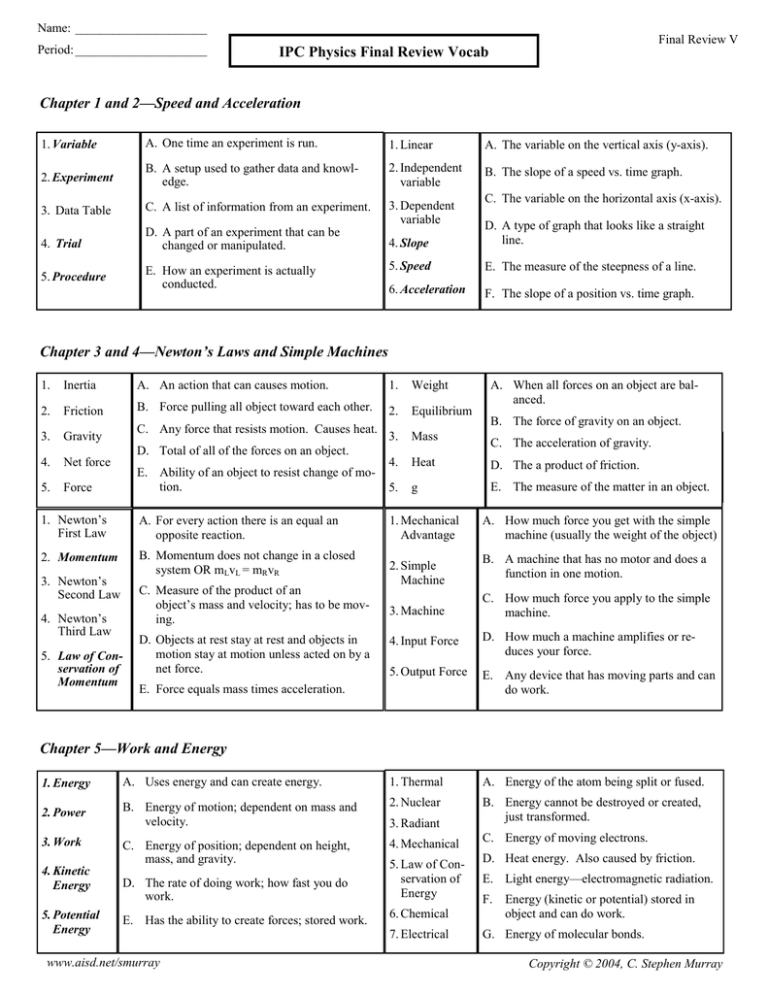
Name: _____________________ Period: _____________________ Final Review V IPC Physics Final Review Vocab Chapter 1 and 2—Speed and Acceleration 1. Variable A. One time an experiment is run. 1. Linear A. The variable on the vertical axis (y-axis). 2. Experiment B. A setup used to gather data and knowledge. 2. Independent variable B. The slope of a speed vs. time graph. 3. Data Table C. A list of information from an experiment. 4. Trial D. A part of an experiment that can be changed or manipulated. 3. Dependent variable 5. Procedure E. How an experiment is actually conducted. C. The variable on the horizontal axis (x-axis). 4. Slope D. A type of graph that looks like a straight line. 5. Speed E. The measure of the steepness of a line. 6. Acceleration F. The slope of a position vs. time graph. Chapter 3 and 4—Newton’s Laws and Simple Machines 1. Inertia A. An action that can causes motion. 1. Weight 2. Friction B. Force pulling all object toward each other. 2. Equilibrium 3. Gravity 3. Mass 4. Net force 4. Heat D. The a product of friction. 5. Force 5. g E. The measure of the matter in an object. C. Any force that resists motion. Causes heat. D. Total of all of the forces on an object. E. Ability of an object to resist change of motion. 1. Newton’s First Law A. For every action there is an equal an opposite reaction. 2. Momentum B. Momentum does not change in a closed system OR mLvL = mRvR 3. Newton’s Second Law C. Measure of the product of an object’s mass and velocity; has to be moving. 4. Newton’s Third Law 5. Law of Conservation of Momentum D. Objects at rest stay at rest and objects in motion stay at motion unless acted on by a net force. A. When all forces on an object are balanced. B. The force of gravity on an object. C. The acceleration of gravity. 1. Mechanical Advantage A. How much force you get with the simple machine (usually the weight of the object) 2. Simple Machine B. A machine that has no motor and does a function in one motion. 3. Machine C. How much force you apply to the simple machine. 4. Input Force D. How much a machine amplifies or reduces your force. 5. Output Force E. Any device that has moving parts and can do work. E. Force equals mass times acceleration. Chapter 5—Work and Energy 1. Energy A. Uses energy and can create energy. 1. Thermal A. Energy of the atom being split or fused. 2. Power B. Energy of motion; dependent on mass and velocity. 2. Nuclear B. Energy cannot be destroyed or created, just transformed. 3. Work C. Energy of position; dependent on height, mass, and gravity. 4. Mechanical 4. Kinetic Energy 5. Potential Energy D. The rate of doing work; how fast you do work. E. Has the ability to create forces; stored work. www.aisd.net/smurray 3. Radiant 5. Law of Conservation of Energy C. Energy of moving electrons. D. Heat energy. Also caused by friction. E. Light energy—electromagnetic radiation. 6. Chemical F. Energy (kinetic or potential) stored in object and can do work. 7. Electrical G. Energy of molecular bonds. Copyright © 2004, C. Stephen Murray Name: _____________________ Final Review V Period: _____________________ Chapter 10—Magnetism 1. Magnet 2. Electro magnet 3. Magnetic field A. Anything that attracts or repels another magnet or magnetic material. B. The area in which magnets will feel magnetic force. More arrows show a stronger one. C. A magnet made from electricity going through wrapped wires. 4. Generator D. Forcing energy into wires by moving magnets. 5. Motor E. Uses energy to cause electromagnets to turn and do work. 6. Magnetic Induction F. Uses work to spin magnets and make energy. Chapter 27—Thermodynamics 1. Conduction 2. Thermal Equilibrium 3. Radiation 4. Convection 5. Thermo dynamics 6. Insulator 7. Conductor A. Heat transfer through electromagnetic waves. B. Will allow heat or electricity to move. C. Thermal (heat) transfer by the contact (touching) of two objects. D. Transfers heat by moving currents in gases and liquids. E. When two objects are at the same temperature. F. Will resist heat and electricity. G. The study of how heat moves. Chapter 6 - 9 — Electricity 1. Electricity A. Slows down the flow of electricity. 2. Current B. Pushes electricity through a circuit. 3. Electrically neutral 4. Resistance C. Electricity can flow through this. D. A circuit that has a wire across a device which causes it to go off. 1. Fuse 2. Circuit breaker B. Has independent paths for the electricity. 3. Parallel Circuit C. Has only one path for the electricity. 4. Series Circuit D. A device that breaks to protect against excessive current. Must be replaced. 5. Open Circuit E. Protects against high current, but can be reset. 6. Closed Circuit F. A circuit that has no breaks in it; electricity can flow in it. E. The flow of electricity through a circuit. 5. Voltage F. Electrons flowing in circuits. 6. Short Circuit G. An object that has equal amounts of positive and negative charges. A. A circuit with a break in it; no electricity will flow. Chapter 11 - 15 — Harmonic Motion and Light 1. Period A. The number of cycles per second. 2. Amplitude B. A unit of one cycle per second. 3. Frequency C. The size or strength of a cycle. 4. Cycle D. Time it takes to complete one cycle. 5. Hertz E. A part of motion that repeats over and over with a set series of events. 1. Absorption A. When a wave bends at a corner. 2. Refraction B. When a wave is dampened inside a soft boundary. 3. Diffraction C. A single particle or packet of light. 4. Reflection 5. 3 x 108 m/sec 6. Photon 7. EM Spectrum D. A wave bouncing off of a hard boundary. E. A wave bending inside transparent objects. 1. Transverse wave A. A wave where the oscillation is perpendicular to the direction of motion. 2. Longitudinal wave B. A wave that is a multiple of another wave. 3. Standing wave C. A wave that is trapped within boundaries; has nodes and antinodes. 4. Harmonic D. A wave where the oscillation is in the same direction (parallel) as the motion. 5. Wavelength E. The length of one wave cycle. 1. Optics 2. Concave 3. Fluorescent 4. Convex F. The fastest speed in the universe: the speed 5. Lens of light. 6. Polarization G. All light: visible and invisible. 7. Fiber optics www.aisd.net/smurray A. The act of only allowing one-directional light to pass through a “filter”. B. The study of how light behaves. C. Technology based on bending light in cables. D. Efficient light because it produces little heat. E. A lens or mirror that is bigger in the middle. F. A lens or mirror that is bigger at the ends. Copyright © 2004, C. Stephen Murray
